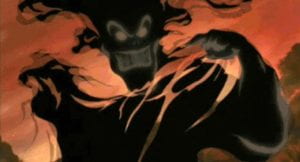On a Friday night around age seven or so, my sister and I eagerly searched through our VHS tapes for FernGully: The Last Rainforest (1992), a family favorite. Though fear of the movie’s smoky evil villain gave me pause, it was finally time for movie night, and I was excited to see the fairies!
It was years later when I came to understand the true impact of this movie. Have you ever considered the underlying lessons embedded in a storyline? Well none has had so clear a call to environmental action as FernGully.

Protagonist Chrysta learning to help a seed grow (Source: Pinterest)
Nearly 30 years after its release, this animated film remains relevant. Throughout the movie, symbolism creates a bridge between youthful imaginations and environmental threats. Fairies inhabit and protect a fictional Australian rainforest, living amongst plants and other animals. They possess magical powers and help the forest grow. As guardians of the balance between forces of destruction and creation, they believe that everything is connected by the delicate strands of life.
Chrysta, the protagonist fairy, befriends and magically shrinks a human logger, Zak. He is forced to experience the world as she does, and he learns to see the inherent value of nature. As a young viewer, the eerie ghostly character of Hexxus was the scariest of them all. When the evil pollution villain arrives, Chrysta and Zak protect the forest with the help from the other fairies and their new bat friend, Batty Koda.
The storyline is derived from Aboriginal Australian roots and a native connection to nature. The movie begins with handprints that mimic Australian Aboriginal artwork. With these references to reality, the film works as a commentary on the loss of interconnectivity between man and nature ー a connectivity that ancestors once embodied.

Australian Aboriginal artwork (Source: Aboriginal Art Australia) and introductory scenes in FernGully (1992) (Source: IMBD)
Many parallels exist between FernGully characters and contemporary themes. Magi Lune is the wise grandmother, present in many animated Hollywood films like Moana and Pocahontas. As the eldest and most knowledgeable of the forest, she warns that the magical power of nature has been forgotten by younger generations. This is evident today. Logging, mining, and extractive industries have gutted the Earth, removing and commodifying core masses of resources. Embodying the role of a God-like figure, we too, have forgotten the power of nature and distorted its intricate balance.
FernGully’s representation of race is also deeply problematic. Its characters, although they exemplify traits of Aboriginal Australian culture, are represented by white people. Thus, it reinforces the White-washing of an issue that is often perpetuated by White people, to the detriment of Native and non-White inhabitants.
Batty Koda, the realist of the movie, is another parallel character who survived human experimentation. He punctures Chrysta’s naive faith in human nature by sharing his experiences. He warns that highways, shopping malls and parking lots will soon replace the forest.
Batty’s warning is just as urgent today. Roads are even created during tree leveling to facilitate further deforestation. Trees are chopped for plantations, crops and pasture, according to the World Wildlife Fund. Currently, agricultural expansion for beef cattle production is a major driver of Australian tree-clearing. Modern mass deforestation is a result of the technological advancements of developed countries, imposing environmental damage and pollution emissions globally.

Hexxus gif (Source: Fandom Villain Wiki)
Hexxus, the evil threat preying on FernGully, refers to himself as a “toxic love” made of oil, gas and poisonous sludge. He represents Exxon Mobil and the power of polluting industries that benefit from forest destruction and resource extraction. The lyrics of his narcissistic song describe humans as the origins of all environmental problems: “Cause greedy human beings will always lend a hand/ In the destruction of this worthless jungle land…/ And what a beautiful machine they have provided/ To slice a path of doom with my sweet breath to guide them.”
Hexxus’s threat has not gone away. An article published in the Guardian exposed the real threat of this villain. It highlighted the disparity between Australia’s pledge for net zero emissions by 2050 compared to the amount of emissions they have actually produced ー which is three times the average of the G20 forum for international economic cooperation. In the 2018 Living Planet Report, Australia was considered among the worst deforesters with the highest rates of land clearings in Queensland.

Deforestation in Queensland 2017 (Source: Conservation.org) and deforestation in FernGully (1992) (Source: IMDB)
In an era of rebooting classics, we need a 30th Anniversary revamping of FernGully. It is disheartening that this movie is still pertinent today. It is an unconventional yet powerful approach to raising environmental awareness, but there is more work to be done in Australia. Perhaps it can lead to more effective ways to inspire and retain the notion of environmental guardianship in children as they grow older. Rebooting could further illuminate far too relevant patterns in human behavior and touch current youth, creating and reinforcing a love of nature for them as this film did for me.